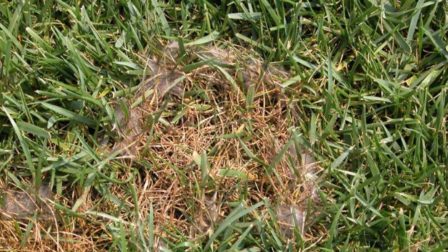“Why is my lawn dying?”
“Why are there brown spots in my lawn?”
“Will it grow back again?”
These questions, and ones like them, are facing many lawn care professionals in the mid-Atlantic region this summer. Here in Lancaster, Lebanon, Dauphin, York, and Cumberland County, our lawns have taken a particularly vicious beating. What’s behind all this? Why does it look that way? There may be a number of culprits to blame, and we’ll walk you through some of them.
Why is my lawn dying? – Poa Trivialis
One common cause of “brown spots” in the lawn is a grass called “poa trivialis” or rough bluegrass. This is an extremely shallow-rooting type of turf, and really deals poorly with any heat stress at all. At the first sign of heat it will begin to wilt and lay on it’s side, making it nearly impossible to mow. Even in a year where we’re getting a decent amount of precipitation, like this year, poa trivialis will enter dormancy or die in the heat. Your lawn dying might be patches of this undesirable grass!
This type of grass is often found in parts of the lawn that have a decent amount of shade and some moisture. It doesn’t necessarily need to be a wet, shady area; a part of the lawn that simply gets more moisture and shade than the rest of the lawn may be susceptible. For example, we often run into this type of turf between homes that are built close together. The grading (sloping away from the home) creates just a bit more moisture in this area. That fact, combined with the proximity of the homes provides enough shade for the turf to grow.
Where Did It Come From?
We often get asked “How did I get it in my yard?” The answer is often that it was in the soil to begin with, and just needed the proper conditions to begin growing. Other times, it could have been introduced during the seeding process. The seeds for poa trivialis are the same size and shape as other types of bluegrass, and often seed manufacturers cannot filter the seeds out, as they would have done with other problems grasses.
When it goes dormant, poa trivialis is often mistaken for a fungal disease. Sometimes the grass is simply dormant. At other times, the grass “laying over” instead of standing up can foster disease issues. Having a professional inspect the lawn is usually a good idea if you are having trouble distinguishing between a dormant grass and a disease problem.
Why is my lawn dying? – Turf Disease
There are several different types of diseases that could be affecting your lawn right now. All turf diseases, like infections in people or animals, rely on what is known as the “Pathogen Triangle” in order to appear. Basically, three things need to be present in order for a disease to grow: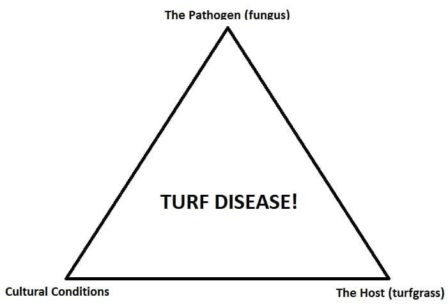
- The Pathogen (in this case, a fungus)
- The Host (your turf)
- The proper Cultural Conditions (circumstances in which the pathogen thrives)
This season, we’ve been dealing with three main culprits.
Brown Patch
Brown Patch is also sometimes called “brown spot” or “summer patch.” This disease, according to Turf Magazine, “…becomes active in the spring or early summer when nighttime temperatures are above 60 degrees Fahrenheit, but is most aggressive when high temperatures are above 90 degrees Fahrenheit combined with high humidity. As a result, brown patch is most destructive in the transition zone where these conditions persist for months on end.”
This disease can be destructive. Often, with some TLC and the return of cooler temperatures, the turf will recover. The other two culprits on our disease list, however, are far more damaging.
Pythium Blight
This disease is running rampant due to the weather conditions we’ve been experiencing. Again, according to Turf Magazine: “Most turf managers think of Pythium blight as a hot and wet weather disease, and that is true on cool-season grasses.”
Pythium spreads through the body of the plant incredibly quickly. It is not unheard of for a severe case of Pythium to wipe out a residential lawn within a day or two. It starts out as a yellowish, cottony-looking mycelium (translation: fungal body) growing on the leaf tissue. Then, it moves rapidly down the leaf tissue into the crown of the plant (where the plant actually comes out of the soil), and this is when plant death occurs.
It may not wipe out the entire lawn, but usually kills infected turf in a very short amount of time.
Gray Leaf Spot
This is a far less common turf disease, and usually effects perennial ryegrass on the fairways of golf courses. However, this season we have seen it in abundance on residential lawns.
Gray Leaf Spot, like Pythium blight and Brown Patch, shows up on turf when we have periods of high humidity followed by high daytime temperatures. According to Penn State, Gray Leaf Spot spores “…can be disseminated by wind, water droplets, or turf equipment.”
Penn State recommends fungicide applications as the most effective way to treat for Gray Leaf Spot. This reason for your lawn dying isn’t incredibly common, but it is aggressive when present.
Cultural Practices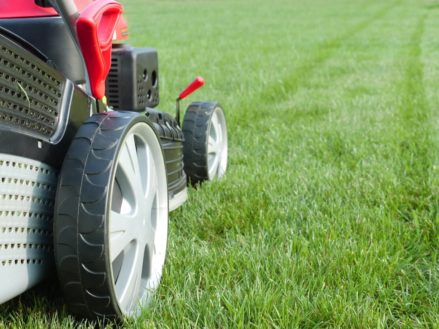
Any time a disease is present in your lawn, we recommend the following cultural practices. These will help to slow the spread of the disease throughout the lawn:
- Bag your clippings – if you have the ability to do so, this minimizes the number of fungal spores being shot across the lawn and spreading the disease further.
- Mow unaffected parts/less affected parts of the lawn first – again, it’s about minimizing the spread of the disease.
- Rinse off the mower when you’re finished – put the mower on an impervious surface, like the driveway or even the street in front of your home, tilt it on its side, and use the hose to rinse all the grass clippings from the bottom. You’ll lessen the spread of those fungal spores if you do this immediately after the mowing is completed. This will also allow the mower time to dry off before it is used next.
Why is my lawn dying? – Insect Damage
There are a handful of insect issues that show up this time of year as well. Some of them you’ll have heard of, but other might be new to you. Here’s some common issues we’ve seen this season:
Grubs
Grubs are the larvae of several species of scarab beetles. There are a six or seven species of beetle in Lancaster, Lebanon, Dauphin, York, and Cumberland County that leave behind a grub in the soil. The most well-known to homeowners is undoubtedly the Japanese beetle.
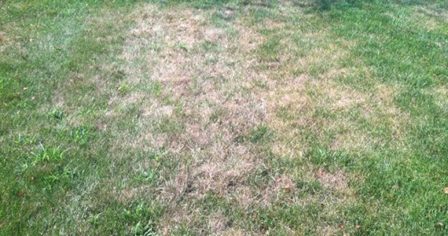 These beetles feed on landscape plants, mate, and lay their eggs in the soil. When those eggs hatch, they reach the next stage in their maturity by feeding on the roots of your lawn. After they’ve eaten enough to grow into their next stage of development, they burrow deep into the soil and wait until the following summer to emerge as fully-grown adult beetles.
These beetles feed on landscape plants, mate, and lay their eggs in the soil. When those eggs hatch, they reach the next stage in their maturity by feeding on the roots of your lawn. After they’ve eaten enough to grow into their next stage of development, they burrow deep into the soil and wait until the following summer to emerge as fully-grown adult beetles.
Grub damage has a very distinctive sign. Most homeowners call throughout the year, and any brown, dead, or dry patch is “grub damage.” It’s a pretty common misconception that grubs are to blame for any and every lawn problem. (See point number five on this blog post from earlier this spring.)
To check for grub damage, get down on your hands and knees on the ground. Run your fingers into the damaged section, like you’re running your hands through your hair. Make a fist, and gently pull back.
If it’s grub damage, the turf will pull back like a rug on a hardwood floor; the root system will be totally gone.
If the roots are still attached, it is definitely NOT grub damage.
There may be other another common culprit to blame, however….
Chinch bugs
Chinch bugs are a very prevalent problem here in Central Pennsylvania for residential lawns. Adults are only about 1/6 of an inch in size, so they’re very tiny and hard to spot.
They do their damage to a lawn with their piercing-sucking mouth-parts. Chinch bugs drain the chlorophyll from the leaf tissue of your lawn (the green stuff that helps the plant turn sunlight into food). Once they’ve done that, they inject a toxin (almost like they’re vomiting) back into the plant, that causes it to turn brown and then die. Chinch bugs have two generations per year, but according to Penn State, can have a partial 3rd generation in years where summer is longer.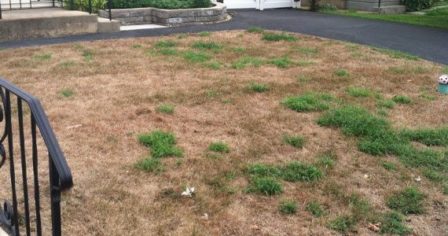
They prefer to feed on fescues, perennial rye, and bluegrasses, all of which are extremely common in our area. Bluegrass seems to be hit especially hard in our area. The threshold for damage on a lawn is only about 15-20 adults per square foot, meaning they’re almost as destructive as grubs, but much smaller and harder to diagnose and control.
Well, there you have it. This list is not exhaustive, but you have a number of answers for “Why is my lawn dying? in the Summer. If you’d like help with a plan of action for helping your lawn recover, be sure to check out next blog post, or feel free to Contact Us for a professional consultation.
Note: picture of Pythium blight courtesy of NC State’s “TurfFiles” blog. You can read the original post here.

